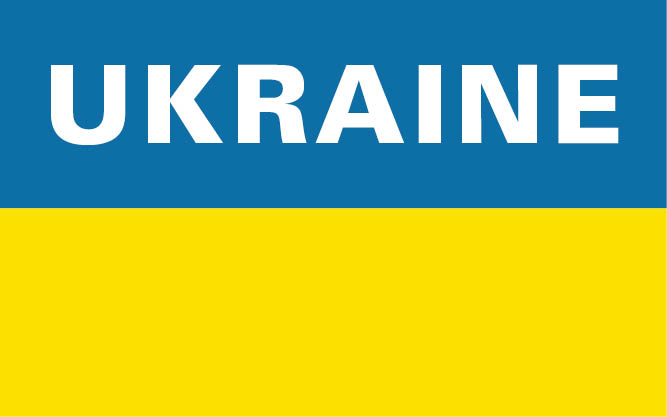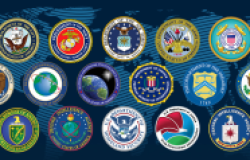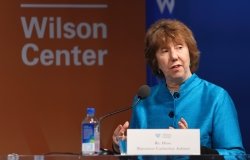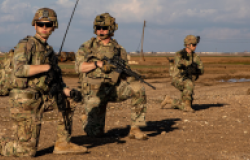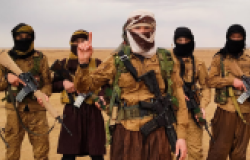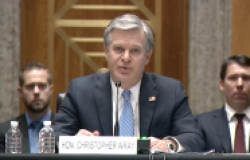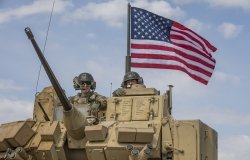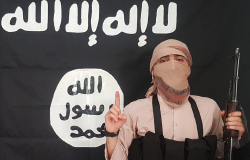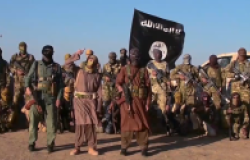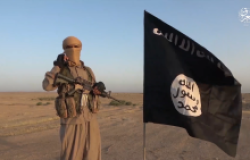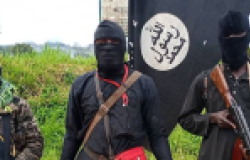ISIS Leader Killed in U.S. Raid in Syria
The leader of ISIS was killed in a predawn U.S. raid in northwestern Syria.
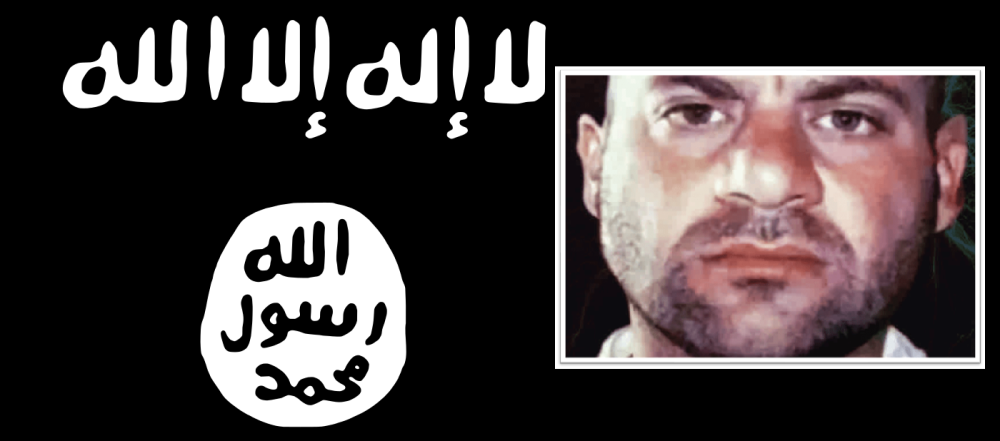
Abu Ibrahim al Hashimi al Qurashi via U.S. Department of State
On February 3, U.S. Special Operations Forces carried out a raid that led to the death of ISIS leader Abu Ibrahim al Hashimi al Qurayshi, also known as Hajji Abdullah. Rather than risk capture, Qurayshi detonated a suicide vest that killed himself, his wife and children. Qurayshi had overseen “the spread of ISIS-affiliated terrorist groups around the world after savaging communities and murdering innocents” since taking over as leader in 2019, Biden said. The operation in northwestern Syria “is a testament to America’s reach and capability to take out terrorist threats no matter where they try to hide anywhere in the world.”
Qurayshi was the third jihadi leader to die in a U.S. operation in the past decade. In 2011, President Barack Obama deployed U.S. Navy SEALs to northern Pakistan, where they shot al Qaeda leader Osama bin Laden at his compound. In 2019, President Donald Trump sent special forces to raid the home of ISIS leader and founder Abu Bakr al Baghdadi. Baghdadi blew himself up during the operation in northern Syria.
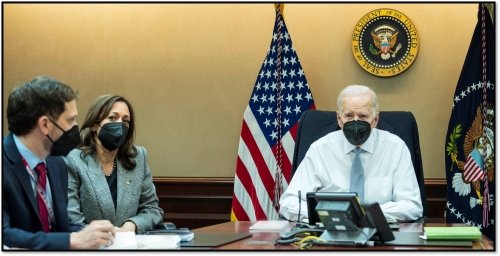
White House photo [Public Domain]
Just days after Baghdadi’s death in October 2019, ISIS named Qurayshi as its new leader. Qurayshi was a nom de guerre he adopted for his new position. He was born Amir Muhammad Said Abdal-Rahman al Mawla in 1976 in Nineveh province in Iraq. The son of an imam grew up in Mosul.
In the mid-2000s, Qurayshi joined the group that would evolved into ISIS. He eventually became a senior idealogue and judge. He “helped drive and justify the abduction, slaughter, and trafficking of the Yazidi religious minority in northwest Iraq and also led some of the group’s global terrorist operations,” according to the State Department. But unlike Baghdadi, he was not a well-known name outside of ISIS.
Qurayshi kept a low profile even after becoming the emir. ISIS did not circulate photographs or provide biographical details about him. And he never released an audio message. But he provided “near constant operational guidance to ISIS fighters,” according to the Pentagon.
U.S. intelligence eventually tracked Qurayshi to rebel-held Idlib province in northwestern Syria. Before dawn on February 3, helicopters carried some two dozen commandos to the town of Atmeh, near the border with Turkey. To minimize civilian casualties, Biden sent special forces instead of ordering an airstrike. The ground forces were backed by drones and fighter jets. U.S. forces closed in on a three-story cinder block building and, through bullhorns, told everyone inside to surrender.
On the third floor, Qurayshi detonated an explosive, killing himself and several others. An intense battle then ensued with his deputy on the second floor. The operation lasted for about two hours. Five combatants and four civilians were killed, the Pentagon reported, although the White Helmets, a Syrian civil defense organization, said that at least 13 people—including six children and four women—were killed. U.S. forces managed to evacuate 10 civilians, including eight children, from the building.
The loss of Qurayshi, one of the few remaining “legacy leaders,” was expected to “lead to disruption within ISIS,” a senior Biden administration official said on February 3. He was “heavily involved in running many of the operations, including many of the external operations.”
But ISIS still posed a threat globally. A former senior U.S. official said that ISIS was deep in the throes of planning attacks in Europe. It has also developed a decentralized model. Its thousands of fighters thousands of fighters in branches from West Africa to Southeast Asia were not necessarily dependent on the core leadership in Iraq or Syria for direction. As of early 2021, the United Nations estimated that the group had up to 10,000 fighters in Syria and Iraq alone. ISIS claimed responsibility for 868 attacks in the two countries in 2021.
In January 2022, just a week before the U.S. raid, ISIS launched a fierce attack on a prison in northern Syria where 3,000 of its fighters were held. More than 500 people died in the 10-day battle, which drew in U.S. airstrikes. The U.S.-backed Syrian Democratic Forces, a Kurdish-led group, said that ISIS spent six months planning the operation and drew from sleeper cells spread across the region. Since ISIS lost its last bit of territory in 2019, most of its attacks have been low-level hit-and-run attacks and bombings. But the raid and a string of other more complex attacks suggested that ISIS was rebuilding its capabilities.
“The fight against ISIS continues,” Secretary of Defense Lloyd Austin said on February 3. “Their leader may be gone, but their twisted ideology and their intent to kill, maim and terrorize still threaten our national security and the lives of countless innocents.” The following are links to U.S. statements on the Qurayshi raid, followed by the full text.
- President Joe Biden
- Secretary of Defense Lloyd Austin
- Secretary State Antony Blinken
- Senior Administration Officials
- General Kenneth McKenzie Jr. - Commander, U.S. Central Command
- Pentagon Press Secretary John Kirby
President Joe Biden
Statement on Feb. 3, 2022: Last night at my direction, U.S. military forces in northwest Syria successfully undertook a counterterrorism operation to protect the American people and our Allies, and make the world a safer place. Thanks to the skill and bravery of our Armed Forces, we have taken off the battlefield Abu Ibrahim al-Hashimi al-Qurayshi—the leader of ISIS. All Americans have returned safely from the operation. I will deliver remarks to the American people later this morning. May God protect our troops.
Remarks on Feb. 3, 2022: Good morning. Last night, operating on my orders, United States military forces successfully removed a major terrorist threat to the world: the global leader of ISIS, known as Hajji Abdullah.
He took over as the leader of ISIS in 2019 after the United States counterterrorism operation killed al-Baghdadi.
Since then, ISIS has directed terrorist operations targeting Americans, our Allies and our partners, and countless civilians in the Middle East, Africa, and in South Asia.
Hajji Abdullah oversaw the spread of ISIS-affiliated terrorist groups around the world after savaging communities and murdering innocents.
He was responsible for the recent brutal attack on a prison in northeast Syria holding ISIS fighters, which was swiftly addressed by our brave partners in the Syrian Democratic Forces.
He was the driving force behind the genocide of the Yazidi people in northwestern Iraq in 2014.
We all remember the gut-wrenching stories: mass slaughters that wiped out entire villages, thousands of women and young girls sold into slavery, rape used as a weapon of war.
And thanks to the bravery of our troops, this horrible terrorist leader is no more.
Our forces carried out the operation with their signature preparation and precision, and I directed the Department of Defense to take every precaution possible to minimize civilian casualties.
Knowing that this terrorist had chosen to surround himself with families, including children, we made a choice to pursue a special forces raid, at a much greater risk than our — to our own people, rather than targeting him with an air strike. We made this choice to minimize civilian casualties.
Our team is still compiling their report, but we do know that as our troops approached to capture the terrorist, in a final act of desperate cowardice, he — with no regard to the lives of his own family or others in the building, he chose to blow himself up — not just with a vest, but to blow up that third floor rather than face justice for the crimes he has committed, taking several members of his family with him just as his predecessor did.
I’m grateful for the immense courage and skill and determination of our U.S. forces who skillfully executed this incredibly challenging mission.
The members of our military are the solid-steel backbone of this nation, ready to fly into danger at a moment’s notice to keep our country and the American people safe, as well as our Allies.
And I’m also grateful to the families of our service members. You serve right alongside your — these soldiers and sailors, Marines, special forces — the loved ones, giving them the strength and support they need to do what they do.
To our service members and their families: We are forever grateful for the — what you do for us, and we owe you a debt. Thank you.
We’re also aided by the essential partnership of the Syrian Democratic Forces.
I want to commend our dedicated intelligence community, the Department of Defense, and members of our national security team throughout the government whose meticulous and tireless work over the course of many months ensured that this mission succeeded.
This operation is testament to America’s reach and capability to take out terrorist threats no matter where they try to hide anywhere in the world.
I’m determined to protect the American people from terrorist threats, and I will take decisive action to protect this country.
And we’ll continue working with our close allies and partners — the Syrian Democratic Forces; the Iraqi Security Forces, including the Kurdish Peshmerga; and the more than 80 members of the global coalition — to keep pressure on ISIS, to protect our homeland.
We remain vigilant. We remain prepared.
Last night’s operation took a major terrorist leader off the battlefield. And it sent a strong message to terrorists around the world: We will come after you and find you.
Once again, today, we continue our unceasing effort to keep the American people safe and to strengthen the security of our Allies and partners around the world.
I want to thank you all. And may God bless you. And may God protect our troops.
Secretary of Defense Lloyd Austin
Statement on Feb. 3, 2022: I am immensely proud of the U.S. forces who conducted an operation against Abu Ibrahim al-Hashimi al-Qurayshi, the leader of ISIS. He detonated an explosive device during the operation, killing himself and members of his family.
The professionalism, skill and readiness of our troops — honed through relentless rehearsal — has dealt ISIS a severe blow and has helped make our country and our fellow citizens safer.
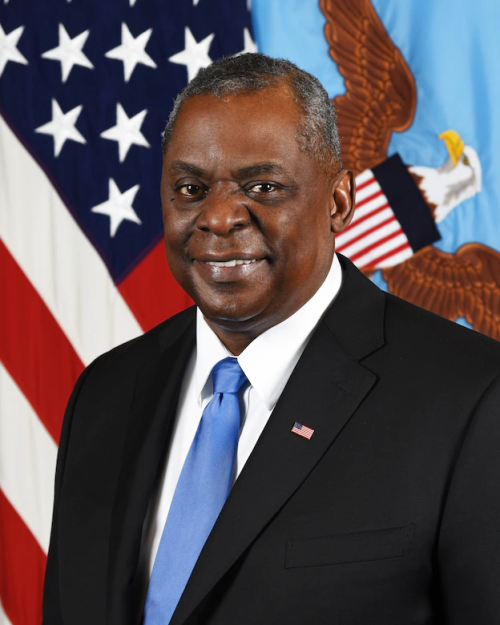
U.S. Department of Defense
Al-Qurayshi, also known as Hajii Abdullah, provided near-constant operational guidance to ISIS fighters, to include the prison break and attack at Hasakah and the slaughter of Yazidis in Iraq. He is now off the battlefield and out of command, and cannot threaten any more lives.
I also want to praise the leadership of U.S. Central Command and U.S. Special Operations Command for their superb support to the planning and execution of this dangerous mission. I've been involved with enough of these sorts of operations to know how difficult they are to mount and how meticulously they must be planned and resourced.
I know the rest of the Department shares my pride in them and my deepest gratitude.
Let me take this opportunity to note that the Department takes seriously our commitment to avoid civilian harm in the course of our operations. This operation was specifically designed and conducted in a manner to minimize civilian casualties. We know that al-Qurayshi and others at his compound directly caused the deaths of women and children last night. But, given the complexity of this mission, we will take a look at the possibility our actions may also have resulted in harm to innocent people.
The fight against ISIS continues. Their leader may be gone, but their twisted ideology and their intent to kill, maim and terrorize still threaten our national security and the lives of countless innocents.
We saw that evil determination in full display during the Hasakah prison break and the fighting that ensued.
And so, we will stay at it … encouraged by the bravery we witnessed last night and emboldened by the knowledge that ISIS, though still very much a viable threat, is now weaker.
Secretary of State Antony Blinken
Statement on Feb. 3, 2022: The military operation authorized by President Biden and carried out by U.S. forces last night in northwest Syria has resulted in the death of Abu Ibrahim al-Hashimi al-Qurayshi, the leader of ISIS – a significant victory in the global fight to disrupt and dismantle ISIS.
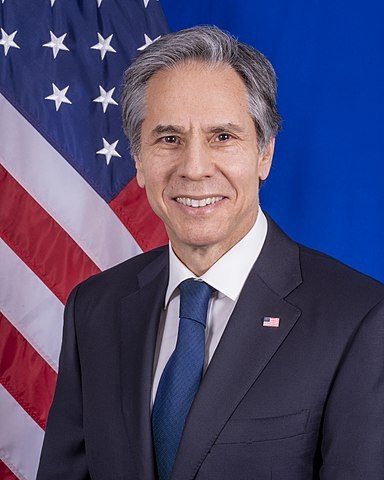
This successful operation is a credit to our brave service members and national security professionals, who undertook this mission at President Biden’s direction after months of careful planning. Throughout that process, the United States took extraordinary care to protect innocent lives and prevent noncombatant casualties. ISIS, however, once again revealed its disregard for human life, including that of women and children, when al-Qurayshi choose to detonate a suicide bomb, killing his own family.
Al-Qurayshi, also known as Hajji Abdallah, took over ISIS in October 2019 after years of serving as a senior leader in the terrorist organization. He was known for his brutal enforcement of ISIS’s vicious ideology and was a driving force behind ISIS’s violent campaigns to subjugate communities and oppress perceived enemies, including the Yazidis, a religious minority in Iraq. He coordinated the group’s global terror operations during a period in which ISIS expanded its geographic presence and attacks in Africa.
This operation was part of a larger mission by the members of the Global Coalition to Defeat ISIS to deny ISIS’s territorial control in Iraq and Syria, counter ISIS’s messaging and financing, and stabilize areas that have been liberated from ISIS to prevent the group from resurging. Al-Qurayshi’s death strikes a significant blow against ISIS. Now the United States and our partners in the Global Coalition to Defeat ISIS will continue the effort. Our goal is the enduring defeat of ISIS and that fight continues.
Senior Administration Officials
Background press call on Feb. 3, 2022:
SENIOR ADMINSTRATION OFFICIAL: Operating on the President's orders, U.S. military forces, last night, successfully targeted Abu Ibrahim al-Qurashi, also known as Hajji Abdullah, the leader of ISIS and the successor to Abu Bakr al-Baghdadi.
Hajji Abdullah coordinated the group's global terror operations to include directing operations that posed a direct threat to the American people and our partners around the world.
He was a driving force behind the genocide of the Yazidi religious minority in northwestern Iraq in 2014 and the enslavement of thousands of young Yazidi girls, using rape as a weapon of war.
He oversaw the network that included ISIS branches around the world, from Africa to Afghanistan.
He was directly overseeing activities of ISIS across Iraq and Syria, which were seeking to reconstitute under his leadership.
The world is a safer place with him gone.
Let me provide some context on the President's command and direction of yesterday's operation, and then I'll turn it over to my colleague at DOD to provide some updates and tactical aspects.
This operation has been months in planning. The President was first briefed on the operation in depth over a month ago by the operational commanders and after we learned that Hajji Abdullah was definitely in this site.
The President was regularly updated by his national security team on the planning details of this operation, to include a brief in the Oval Office earlier this week.
He gave the final go on this operation on Tuesday morning, with the Secretary of Defense and the Chairman of the Joint Chiefs, General Milley, in the Oval Office.
Last night, the President monitored key aspects of the operation in real-time in the White House Situation Room, receiving reports from the Secretary of Defense, the Chairman of the Joint Chiefs of Staff, and General McKenzie and their teams.
This operation is consistent with the President's commitment to take out threats to the American people wherever they are and in any manner that does not require large deployments of U.S. forces.
We are especially grateful for our local partner, the Syrian Democratic Forces, whose support was essential to the mission's success and with whom we will continue to relentlessly pursue remnants of ISIS and its leadership.
Let me say a few words about the operation itself. The President, of course, directed the Department of Defense to take every precaution to minimize noncombatant casualties in this operation.
That was particularly challenging here because Hajji Abdullah seemed to purposefully live in a residential building, with families on the first floor that we believe had nothing to do with ISIS and did not know who was living on the third floor.
Hajji Abdullah never left the house. He commanded by couriers who came and went. He used these innocent people as his shield.
It was due to the risk of this unwitting family and other civilians in the area that President Biden ordered this air assault operation, placing our own troops at risk to minimize the risk to others. And they succeeded in that mission.
In the earliest stages of the operation, a family on the first floor -- one woman, one man, and a number of children -- were safely removed from the site.
Unfortunately, ISIS once again revealed its barbarity. In a final act of cowardice and disregard for human life, Hajji Abdullah detonated a blast -- a significant blast -- killing himself and several others, including his wife and children.
This is the same terrorist tactic of his predecessor: taking his own life and his own family, rather than face justice or stand and fight on his own. Both these terrorist leaders murdered their own families.
In this case, the blast was so large, on the third floor, that it blew bodies outside of the house and into the surrounding areas.
All casualties at the site were due to the acts of ISIS terrorists inside the residence, including Hajji Abdullah, who set off this charge destroying most of the third floor.
An associate of Hajji Abdullah -- another ISIS terrorist, an ISIS lieutenant -- barricaded himself and members of his own family in the second floor. He and his wife engaged the assault force. They were killed in the course of the operation.
After the second ISIS terrorist was eliminated, an additional number of children came out of the second-floor dwelling area and were safely removed from the site.
ISIS has made clear over and over again its utter and complete disregard for human life. And that was clearly on display throughout the operation last night.
Looking ahead, the terrorist threats we face today are more ideologically diverse and geographically diffuse than 20 years ago. Groups such as ISIS and al Qaeda have expanded across Africa and Southeast Asia. These global networks and affiliates still aspire to attack the United States.
Years of sustained counterterrorism operations, pressure has forced them to shift their operating models and constrain their capabilities, but the threat remains serious.
Our partnership at the international, national, and local levels are vital to our success. And this is not solely a military effort. Working in concert with a global coalition of over 80 partners who are working to share intelligence, repatriate foreign fighters, prosecute ISIS leaders, and perhaps most importantly, deescalate regional conflicts and stabilize former ISIS safe havens to ensure these groups can not -- never again resurge and threaten the American people.
President Biden has redoubled our commitment to stabilizing areas liberated from ISIS in Iraq and Syria, and recommitted to our vital partnerships in the region to include the counter-ISIS coalition, NATO, and our local and regional partners, all of whom remain essential to this ongoing effort.
The bottom line is that President Biden remains steadfast in his commitment to protecting the American people from the threat posed by terrorist groups. Last night’s successful action took a major terrorist leader and his lieutenant off the battlefield, makes it clear that we will hold anyone accountable who seeks to harm Americans at home or around the world.
And I think the key facts of this operation, again, just show the barbarity of these ISIS terrorists. All the casualties at the site were due specifically to their actions, including the significant detonation of Hajji Abdullah and the decision of his lieutenant to barricade himself on a second-floor room and engage U.S. assault forces.
And with that, I will turn it over to my colleague at the Department of Defense.
SENIOR ADMINISTRATION OFFICIAL: So, ladies and gentlemen, just to give you a little bit more background on the specific operational aspects to reinforce some of what was earlier said: So, this is an operation that has been long in planning and, from a tactical perspective, went precisely as expected.
The overall goal here was to remove Hajji Abdullah from the battlefield, and that was successful. Much of what was built into this operation was explicitly and predictably based on protecting non-combatants. We had good sense of who was in the building, as has already been briefed, and had taken numerous safeguards throughout the rehearsals and planning to protect those individuals.
What we can’t account for, of course, is actions taken by the targeted individuals themselves. And in this case, it appears that they chose to detonate explosives or take other hostile action that resulted in the deaths of their relatives.
And with that, we can go through some of the details here of some of the operational mechanics for your benefit.
So, with the idea that noncombatants would be protected, it was an explicit decision to conduct a raid as opposed to a standoff strike of any sort. With that, the raid force took a number of steps, including conducting call-outs -- so, announcing their presence, asking people to leave the building, which resulted in some of the innocents coming out, as already has been briefed. We were conscious of the fact that this is a residential area and there were also children in the building.
There were also multiple messages to local components around -- this would be civilians and others -- to ensure that they knew what was underway and didn't in some way interfere, unintended or intended.
But intense care taken throughout the operation. Much of this was built, again, on the idea that we knew that this was a complex target.
I will highlight a few other things just because we know it's been out there already. Once again, the target for this operation was the ISIS -- overall ISIS Amir, Hajji Abdullah. There were other reports of other targets -- al Qaeda and others. That's not -- that's not truthful.
There was a situation in which one of our helicopters had a mechanical issue, and so it was properly disposed of some distance from the site; it had nothing to do with any kind of hostile action. This was a mechanical issue, best we can tell at this early stage.
And then, further in the course of what was nearly two hours on the ground -- which was the plan initially and continued to be the plan that was carried out -- towards the end of that period, there was hostile action from local forces. I think it's important to keep in mind that this area is controlled by, in many cases, Hay'at Tahrir al-Sham, which is, by our estimate, a group that is a terrorist group; it certainly has al Qaeda affiliations.
At least some of those individuals engaged one of our helicopters, and we took action that resulted in, as we know it at this point, at least two enemy killed in action. So some of the reports from the ground will highlight that as well.
That's the operational laydown that augments what was already said.
QUESTION: Please give me a sense of how many civilians you estimate were killed. And what was the mechanical issue with the helicopter? And finally, was this ISIS leader in any way connected to the bombing at Abbey Gate?
SENIOR ADMINISTRATION OFFICIAL: Some of the numbers that are reported out there do not align with our information. We believe the number of children that came out of this site, according to the force that oversaw this and would monitor it in real-time, a number of eight children were removed from the site safely.
The casualties were all from the third-floor detonation of Hajji Abdullah's -- the third-floor dwelling area, and the barricaded -- his lieutenant on the second floor. Those were the only casualties on the site.
And some of the numbers out there don’t align with our information, but I can't say specifically how many people Hajji Abdullah had with him when he decided to murder them.
On the second question, I'll turn it over to DOD.
SENIOR ADMINISTRATION OFFICIAL: So the helicopter was a mechanical issue on the insertion; that, ultimately, that helicopter was able to extract itself from the immediate target area and, under control, able to land in another location where the decision was made to disable it and destroy it.
So, no casualties on the U.S. side throughout. I think we highlighted that, but certainly not with the helicopter.
And then, on your last question on Abbey Gate: The Abbey Gate attack, of course, was ISIS Khorasan, which is an affiliate of ISIS and recognizes Hajji Abdullah as the overall Amir of ISIS. So that's the connection we would draw.
QUESTION: Can you just describe again how it happened on the second floor with the lieutenant and who was killed and who was -- how many survivors came out of that?
SENIOR ADMINISTRATION OFFICIAL: So the assault force on the second floor, we knew that Hajji Abdullah lived in this residence with another ISIS terrorist, lieutenant of his. And he was involved in making sure that -- even though Hajji Abdullah, again, never left his residence, because he used these -- his own family and the residents -- the family on the first floor, including a number of children -- basically as his human shields.
The lieutenant kind of helped him run day-to-day operations. Again, couriers came in and out. So we knew this lieutenant was in the house. And he barricaded himself in a room on the second floor and engaged U.S. forces, as did his wife.
After that, the threat from them was eliminated. As I mentioned, four children came out of the second-floor dwelling areas. The ISIS lieutenant and his wife were killed. And they may have had their children -- don't know numbers -- with them in that room. So that's something that still has to be confirmed.
But four -- after that engagement, four children came out of the second floor and were safely -- were brought to safety.
I have to say, I think you can get a sense of the complications of this and the care that went into it. I've seen some reporting that the fact that the operation lasted two hours was unusual.
I think, as [senior administration official] said, everything here ran, really, according to clockwork. And as the planning went, we were in the Situation Room for the two hours of the operation on the ground, as was planned.
And I think the complications was just because the leader of ISIS decided to run this global terror network in a house with an innocent family and others living on the first floor.
QUESTION: I know you said that this mission was in planning stages for a long time. Can you say whether the raid on a prison in Syria by ISIS and the recapturing of that, whether that played at all into the timeline of actually carrying out this operation?
And secondly, what is your assessment of the extent to which this killing will affect the future of ISIS in Syria and abroad?
And lastly, if you can just talk at all about any of the intelligence that led to that raid -- what type of intelligence, and how the U.S. came to act on that intelligence. Thanks.
SENIOR ADMINISTRATION OFFICIAL: Let me just -- as the intelligence came in -- that we believed we had a lead on Hajji Abdullah -- of course, the President was briefed on this immediately and directed all of the whole interagency and national security team following these issues to make sure we did everything we possibly could to confirm his identity, and then, the President, obviously directing his military intelligence team to find the best mechanism to take this terrorist off the battlefield.
So, that whole process was really months -- months in process. The final fix of this certainty that this was Hajji Abdullah, I think it’s safe to say about early December or so.
And the President was briefed in December in detail, including, again, operational commanders came in to the Situation Room and briefed the President on a number of possible options for taking down this terrorist target, including the extraordinary complexity because of the number of children in the area, the families on the first floor, and the fact that Hajji Abdullah, with the exception of sometimes going to pray on his roof, never came out of the house. He ran ISIS through couriers and by staying on the third floor of his residence.
So, an incredibly complex endeavor. The President was directly involved throughout these deliberations, a constant give-and-take with his commanders and the national security team. And, again, gave the final go for this operation on Tuesday morning in the Oval Office.
So, this was a process that was obviously months in work by our intelligence community to find a fixed location and our military team to develop options to present to the President.
So, that was basically the process here.
The prison -- Hajji Abdullah directly was overseeing these operations in Syria, and including the prison, we believe. But, no, the timing of the operation was not -- was not tied to the prison operation at Hasakah.
[Senior administration official], anything else you want to add?
SENIOR ADMINISTRATION OFFICIAL: I'll just pick up on that theme, to answer the third question. So, we think the impact of Hajji Abdullah being removed is going to be a blow to ISIS because he's -- even while Abu Bakr al-Baghdadi was the Amir, Hajji Abdullah was heavily involved in running many of the operations, including many of the external operations; as was already alluded to, was certainly influential in what was multiple threat streams against the Hasakah prison.
So, we anticipate that this is going to lead to disruption within ISIS. He's really one of the few remaining, shall we call them “legacy leaders.” And so, this is a continued push that has been underway for quite some time to continue to remove the leadership elements of ISIS.
QUESTION: Let me ask you, kind of, broadly, in the aftermath. The United States has killed Bin Laden and Baghdadi and now the latest ISIS leader. What is the state of jihadism? You mentioned how -- its global spread. How much harder is it for the United States to counter its efforts? How much better off or worse off are we are than in the early days?
Secondly, can you describe the Situation Room and what, you know, some of the atmospherics of what Biden was doing. Were there moments of tension? Were there moments of -- (inaudible) of work?
And finally, the SDF, how much of a role did it play in the initial intelligence -- locating this guy, doing the legwork and the prep for this raid?
SENIOR ADMINISTRATION OFFICIAL: Let me hit some of that. Just on the state of ISIS -- of course, it wasn't long ago, Robin, you were covering -- they controlled a caliphate with 8 million people and were carrying out attacks all around the world in Paris, Brussels, elsewhere.
Obviously, it’s significantly degraded. The leader of ISIS, Hajji Abdullah, hiding in a residential area, living on a third floor of a residential facility, but still in command of ISIS through a network of couriers and a global network, which obviously we have pretty good fidelity into.
So I think just the extraordinary work of our professionals who do this day-to-day, very difficult work are keeping the American people safe. And I'll turn it over to [senior administration official] for some more details on the state of the global jihad situation.
The SDF is essential. We cannot do any of this without them. So, just critical. I don't want to get into any details, but critical, vital enablers for operations like this.
In the Situation Room, we've monitored the operation in real-time, again, from shortly before the forces on the ground to when they landed. The President came in with the Vice President and was receiving real-time reports from, as I mentioned, Lloyd Austin and General Milley and Frank McKenzie in real time. So it was real-time monitoring. We were able to monitor the situation with the helicopter mechanical failure. The fact that -- which we were all very focused on. Obviously, tremendous tension, just given the number of children we knew were in the house, on the first floor.
It was a relief when one of the first reports was that when the team came on site and called everyone to come out, those on the first floor did come out and were led to safety. Because, obviously, that was a key point of concern and why this operation was so complex.
There was then a report, before the assault force went into the house, of the significant explosion on the third floor, which later confirmed was Hajji Abdullah detonated basically the third floor -- the third floor of the residence, killing himself and murdering his own family. That happened fairly early in the operation.
And then, the second floor, a terrorist barricading himself and engaging our forces.
So this all kind of ran, you know, kind of in a linear fashion throughout the operation.
We also had the engagement, as [senior administration official] mentioned, with one of our helicopters, which we were able to -- also able to monitor.
The President was obviously pleased with the reports from his commanders -- tremendous praise for our team. And when the team was wheels up, the President left the Situation Room. He said, “God bless our troops." And I think Jake kept him informed throughout the night because they had to do another couple of stops to obviously get to safety. And that was the operation.
So, a very -- after months of planning, the President being very steeped in the operational details. The commanders, as I mentioned, came into the Situation Room in December with a tabletop model of this site, which demonstrated where Hajji Abdullah was and the complexity of this operation.
This was not without significant, significant risk, both to our force, just given the forces who are in this area, as [senior administration official] mentioned, and also just the nature of this dwelling and the way Hajji Abdullah decided to conduct his affairs. Incredibly complex, high risk.
And the President just -- at the end just praised the professionalism -- incredible professionalism of our forces.
Anything else to add, [senior administration official]?
SENIOR ADMINISTRATION OFFICIAL: Maybe just briefly on the overall global terrorist situation.
So I think, as already mentioned, ISIS has really been focused on -- even though their caliphate has been degraded and many of their leaders have been killed or captured -- continues to at least express the intent to conduct attacks against the United States and the West.
But the capability that has been pretty significantly degraded, starting with a series of leadership losses and then the rollback of the territory that [senior administration official] alluded to that they controlled until 2019 -- we nonetheless see an expansion of ISIS branches and networks to over three dozen different countries. But a lot of that is overseen from ISIS Khor -- Hajji Abdullah and others.
We have, on balance, seen fewer attacks against the United States and Western interest in recent years. And we assess that that’s a large function of the pressure that the coalition, some of the local allies, like the SDF and the United States, have placed on the network.
SENIOR ADMINISTRATION OFFICIAL: If I can give one more -- just one more anecdote. We, of course, considered that Hajji Abdullah, on the third floor, might detonate himself in the operation, just given the record here -- Baghdadi, for example.
And our engineers from our military team studying the structure, from the modeling they were able to do, did determine that if in the early phase of the operation Hajji Abdullah were to set off a detonation, that the structure would not collapse. Because one of our main concerns was that he would kill himself and the structure would collapse, killing everyone else in the building.
So, we had high confidence that if this went according to how we thought it might go and did go -- that he detonated himself and murdered his own family -- it would not collapse the building and kill the other people in the building.
I doubt he knew that when he set off that detonation, so he obviously had every intent to take his own life and murder his own family, and at the very least, reckless disregard for everyone else in the building.
We had high confidence that if he did that, as he did, that the building would remain structurally sound as it did. But I just want to emphasize, I doubt he knew that. And it was probably his intent to kill everybody in that building.
But I think that just shows the level of detail that went into planning this operation. And that fact was discussed a number of times with the President -- if Hajji Abdullah were to detonate himself, would the building remain structurally sound, and it did.
QUESTION: Just a couple points of clarification. One, with the helicopter mechanical issue, was there any kind of hard landing or crash? And then, two, it sounds to me like U.S. forces were definitely outside the building when the explosion happened. Do you have any estimate for how far away? Thank you.
SENIOR ADMINISTRATION OFFICIAL: So, the first issue on the helicopter: No, no hard landing. This was the issue that resulted upon the immediate infil. And the helicopter was able to depart the target location and move to another location, at which point it was determined that it was not going to be feasible for it to return to the next location for the return flight.
So, the decision was made to destroy it in place, well distant from the target location. So, well beyond any kind of visual range.
On the question of the distance, as [senior administration official] already alluded to and as extensive experience over the years has shown, oftentimes the tactic used by these types of people barricaded, especially those known to wear suicide vests, is to explode themselves or the building they're in. So the assault force was well outside the range of what we assessed to be the likely explosive impact. And as a result, none of the assaulters were injured in the initial blast, which, again, as [senior administration official] alluded to, occurred very quickly in the operation, shortly after the initial call-out and shortly after the family on the first floor departed.
So, we assessed that to have gone as we had -- as part of our planning. And certainly think that Hajji Abdullah knew that his minutes were numbered, or he was at least going to be captured, and decided to take out not only the third floor but also the women and children with him.
General Kenneth McKenzie Jr. - Commander, U.S. Central Command
In remarks during a Middle East Institute conference on Feb. 3, 2022: Hajji Abdullah “every bit as evil and committed to attacks on the United States and its partners as was his predecessor.”
“While Baghdadi was iconic and a philosopher, in ISIS, was actually far more of an operational planner and director of operations.”
“He was directly or indirectly responsible for numerous atrocities, including those against the Yazidis early on and ISIS' reign of terror in Iraq and Syria.”
“He killed himself and his immediate family without fighting, even as we attempted to call for his surrender and offered him a path to survive.”
“I want to commend the expertise and bravery of the U.S. forces that executed the mission and our interagency partners who planned, supported and executed the mission.”
“I would also like to acknowledge the support of our Syrian Democratic Forces partners in Syria, who made invaluable contributions to the success of the mission.”
“The death of Haji Abdullah is a clear signal that the United States remains focused and committed to finding and eliminating the terrorists who are plotting to do us harm, and we will not rest while their organizations remain committed to terrorism and violence against the international community in the United States of America.”
Pentagon Press Secretary John Kirby
Press briefing on Feb. 3, 2022:
PRESS SECRETARY JOHN F. KIRBY: As you no doubt heard, last night U.S. Special Operations Forces, under the control of U.S. Central Command, conducted a counterterrorism mission in northwest Syria that resulted in the death of ISIS leader Abu Ibrahim al-Hashimi al-Qurayshi, also known as Hajji Abdullah. Hajji Abdullah was a very hands-on leader, and involved in many day-to-day operations of ISIS, and certainly keenly interested in restoring the -- the lethality and the higher OPTEMPO that ISIS had once to -- enjoyed. So his death, we believe, dealt a significant blow to ISIS.
And you've already heard from the president this morning, and I think you've probably seen a statement that Secretary Austin put out, joining the President in commending the professionalism and the skill, the readiness exhibited by our forces in this operation, particularly with the extensive regard towards safeguarding innocent life that we knew was located there at the target's location.
And while the cowardly actions of Hajji Abdullah and the small number of his followers resulted in the death, the tragic death of at least three innocent civilians, the calculated efforts of our forces succeeded in protecting more than 10 women, children and babies. These efforts included a deliberate decision by the president to execute a raid on a location, as opposed to an airstrike, despite the additional risks that that decision put on our forces.
And as I think you've probably seen, in -- in addition to all that, as they got to the site, the -- they called out to everyone in the -- in -- in the building, giving them an -- an opportunity to leave peacefully, quietly, and for Abdullah to surrender himself. Of course, he chose a different route.
https://www.youtube.com/watch?v=cXCe7eyakRA
While there were no U.S. casualties, one of our helicopters did suffer a mechanical failure early on in the infiltration phase of the operation. The helicopter was able to depart the target location and land at another location further away off-site. But ultimately, it was determined that further use of the helicopter was not practical, and in fact, could be dangerous. And so General McKenzie made the decision that the helicopter should be abandoned and -- and detonated so it could be destroyed in place.
So moving forward, I'm sure you've got lots of questions. I'll do the best I can to answer them. I want to remind that this is an operation that is not yet 24 hours old, so while we will provide as much context as we can to you, I suspect, as you all have covered these kinds of things before, that we will continue to learn more information as time goes on. We are still reviewing the results of this operation. We are still going through the -- the after-action process that we always do, and we'll do the best we can to -- to provide you as much context -- context.
I also would add -- and I'm saying this as a bit of a disclaimer here before we begin taking questions -- that there are still operational security matters that we're just not going to be able to speak to. We obviously take these kinds of missions very seriously. We obviously want to be able to continue to conduct these kinds of operations because ISIS remains a threat. So there's going to be some information that you will want to know that we are simply not going to be able to provide so that we can preserve our flexibility to conduct these sorts of operations going forward.
QUESTION: Did I hear you correctly that you said you verified three civilians were killed? And also, could you elaborate on, perhaps explain a little further what Secretary Austin meant in his written statement about looking into the possibility that U.S. actions may have resulted in harm to civilians? What exactly is he referring to?
MR. KIRBY: So we know that -- that when Abdullah detonated an explosive device, which obviously killed him, we know that there were three people on that third floor with him that were also killed, his wife and two children, and -- so that's what I'm talking about when I talk about the -- the -- the three.
We also know, as I said, that we were able to safely evacuate 10 individuals, six from the first floor -- an adult male, an adult female and -- and four children, and then four children from the second floor, which our forces were able to safely get -- to get out of the building. On that second floor, where one of Abdullah's lieutenants engaged our forces -- actually, one of his lieutenants and the lieutenant's wife firing back at our forces. They were killed, and -- and it -- it appears as if a -- a child was also killed on that second floor.
And as for your second question, I mean, we're -- we're -- we're always mindful of the potential for civilian harm, a harm to -- to innocent life. And while the strong indications are here is that -- that the -- that the life -- that the lives taken in this operation, the lives of innocents taken in this operation were caused by Abdullah and his decision of blowing himself up and everybody else with him on that third floor, as well as the resistance of his lieutenant on the second floor, we're willing to take a look to just examine and make sure that there wasn't any action that we might have taken that -- that -- that could have also caused harm to -- to innocents.
QUESTION: You mean indirectly, or do you mean directly?
MR. KIRBY: In any way. I think we're just going to take a look and see. But -- but right now, the strong, strong indications are that to the degree there's a loss of innocent life, it's -- it's a loss caused by Mr. Abdullah and his lieutenant.
QUESTION: You're quite confident on the three? That it's only three people on the floor...
MR. KIRBY: That is the -- that's what we have right now, Bob. I'm -- I'm -- I'm going to give you what I can right now, and I think you know that information can change over time. That's what we have right now.
QUESTION: Any additional information about the team that executed the operation?
MR. KIRBY: No, I don't have any more information about the team that executed the operation.
QUESTION: Any more details about what kind of support or cooperation that the SDF provided to the operation?
MR. KIRBY: The SDF were helpful in -- in -- in enabling our ability to conduct this operation but I'm not going to go into more detail about the -- or what that assistance looked like. I will remind, Pierre , that this was a U.S. operation conducted by U.S. forces only.
QUESTION: Will anyone get a reward for -- justice reward for this tip? And how long have you had this intelligence? Also, you referred to the three innocent civilians but would the wife of Hajji Abdullah be considered an innocent civilian?
MR. KIRBY: I think I'm just going to leave it the way I characterized it. And again, we're going to continue to review and look at this. I think I'm just going to leave it the way I described it.
And as for the reward, I don't have any updates on that, yet there was a $10 million reward on his head. But I don't have any updates on whether that award can or will be claimed.
And then on the intelligence, I would just tell you that this operation was literally months in the planning. And of course, a -- a -- a strong basis for being able to conduct an operation like this is valuable intelligence, intelligence that comes from multiple streams.
And again, without getting into more detail than that, there was as -- obviously, because of the success of the operation, I mean, the intelligence was a mosaic that allowed us the level of awareness and fidelity of information to be able to conduct this in the way we did.
QUESTION: Was he responsible for the Abbey Gate bombing?
MR. KIRBY: I don't have a direct connection to speak to in -- in -- in terms of that. However, he's the -- he was the leader of ISIS and it was an ISIS-K attack. But what we do know is he was a hands-on kind of leader. The -- we know that -- that he certainly had knowledge of and was a -- at -- at least maintaining a level of situational awareness during the Hasaka prison break last -- last week. We know that he was directly involved in the massacre and the -- and the rape of innocent Yazidis back in 2014.
This is a -- this was a man that we should all be happy is no longer walking on the face of the Earth.
QUESTION: Did you get DNA of him and have positive DNA? Is that how you were able to identify? Can you tell us a little bit more about that?
MR. KIRBY: All right. We were able to identify his body through fingerprints and DNA analysis.
Q: On site?
MR. KIRBY: On site. Well, the fingerprint -- I -- the fingerprints were on site. It took a little bit longer to get the -- the DNA analysis, so it was a combination.
Q: Can you give us a little more detail about this firefight that occurred sort of towards the end of this -- the two hour timeframe that they were on the ground, some locals or something? What was that? And (inaudible) were killed?
MR. KIRBY: Yeah, towards -- towards the end of the operation, there were -- there were -- as I -- a small group of individuals approaching the compound. They -- they -- it -- they were appropriately deemed as hostile and they were engaged -- they -- they were engaged.
And we know that it -- in that engagement, two of them were killed, and that resulted in the end of that hostile activity, the remaining -- of -- individuals left the site.
QUESTION: Did they engage on the ground or via air -- by the air?
MR. KIRBY: I -- I don't know exactly. I -- I know that at -- at least some engagement came from the air but I can't be sure that there wasn't some engagement from the ground.
QUESTION: Can you say -- do you know who the lieutenant was? He mentioned he and his wife were -- were killed. I mean, was this someone relatively senior?
MR. KIRBY: It -- it was a -- it was a -- a senior lieutenant of Abdullah. I don't have the -- the name -- you can say it -- you can say it was a -- a deputy.
QUESTION: And then can you -- was this mission a -- a kill or capture mission? Was there ever an effort to try to take him alive?
MR. KIRBY: I -- I won't -- you know, without getting into the specifics of -- of the orders, this -- it was a raid against Abdullah, and again, he decided to kill himself and others before coming into direct contact with the -- the assault force. The -- he did not fight back.
The objective was to finish his leadership of ISIS, and that was achieved.
QUESTION: And then finally, the question I'm sure all of us are wondering -- was there a dog involved? What was its name? And do you have a photo?
MR. KIRBY: I do not know and I do not know.
QUETSION: Why did the mission take two hours for -- what -- what was the process? I mean, was there a calculated process to get civilians out of this building? Was that a part of the delay? Because it sounds like two hours on the ground is quite a long time for the -- one of these kind of missions.
MR. KIRBY: First of all, the plan was to have them there for two hours. From the get go, the -- the plan was for two hours on site. And it speaks to the level of care that U.S. Special Operations Forces used in this mission, which was designed to preserve innocent life.
I mean, to -- to go to the site, as they did -- first of all, it was securing and isolating the site, then it was to get innocents and, quite frankly, to encourage Mr. Abdullah to leave this site, and that's why they used a bullhorn and -- and made several callouts, beseeching everybody in that building to leave. That takes some time too. You want to make sure you make a good faith effort to do that, and we did.
They were engaged at -- there was a -- a -- an explosion on the third floor and engagement, gunfire from the -- from the building, and then they -- they had -- they -- they went in. And obviously, you want to process the site as best you can, get as much information as you can, and of course, in this -- in this regard, because he chose to end his life the way he did, to be able to identify and then safely leave -- leave the site.
So honestly, from -- from soup to nuts, the original plan was to have them there for two hours and they were there for just about exactly two hours.
QUESTION: I think the characterization has been, by other officials, that -- that he detonated this explosive very early on, after the arrival of the troops. I mean, do you have a -- a notion of how quickly he did that or was this a long, drawn-out process?
MR. KIRBY: That -- I don't have the exact minute by minute tick-tock, but that characterization, as I understand it, is -- is accurate -- it wasn't long after they isolated and secured this site and began the callouts that there was a large explosion on the third floor, which turned out to, of -- of course, been Abdullah killing himself and -- and the family members that were with him on the third floor, and -- and -- and putting at significant risk everybody else in that building.
QUESTION: And then one more please -- the -- the Kabul air drone strike and the repercussions that have happened. Since then, we saw the Secretary issue his guidance recently. Did that factor in at all into the notion of that "we're going to go in with ground troops in an air -- a raid, as opposed to a drone strike"?
MR. KIRBY: What factored into that decision, (Luis), was our longstanding practice of trying to minimize civilian harm, not what happened on the 29th of August or on any other day, but -- but a longstanding desire to minimize civilian harm.
And the President made that decision and it was a significant decision because it involved putting our troops at much greater risk in order to do it this way. But that's in keeping with a -- a longstanding desire by us to -- to try to minimize civilian harm as much as possible.
QUESTION: Just a follow up question to civilian casualties -- you said there were three on the third floor, the wife and two kids, but you also said it appears as if a child was also killed on the second floor.
MR. KIRBY: ... when I said -- when I was referring to the three, I was -- I was talking about the context of him killing himself.
QUESTION: And then who -- who killed the child on the second floor?
MR. KIRBY: Again, I'm not going to get into a -- a blow-by-blow on every single event here. We are still processing this, Oren. It's not even 24 hours old. We're giving you as much information as we can right now. Information will continue to flow in, and as we can share it with you, we will.
... let it -- let it not be forgotten, though, that we also, you know, saved -- helped save 10 lives, including four kids on that second floor. So 10 -- 10 people, mostly children, we were able to get out of that building safely because of the care that was put into that mission.
QUESTION: One follow up question -- did any of those who took part in the planning for either the Bin Laden raid or the -- or the Baghdadi raid take part in the operation or execution of this raid, as well?
MR. KIRBY: I don't know.
QUESTION: Sir, about the children, those who were killed or those who are saved, who are they, do you think, right? Who -- who are the civilians in the -- who were the civilians in the building?
MR. KIRBY: Again, I want to be careful here, as I don't -- we don't have perfect knowledge of -- of every single individual that was killed in this -- in -- in this raid. We know Hajji Abdullah was killed, we know his lieutenant that was on the second floor was killed, we know that, when he blew himself up on the third floor, three others went with him. And we know of at least one child that was killed on the second floor.
But I -- you know, I -- I don't -- I don't have much more information to give you than that.
QUESTION: (inaudible) are there any civilians under U.S. custody right now? Where -- where did the -- the -- the -- when the -- saved ones go after the operation?
MR. KIRBY: There is no -- there are -- there's -- there's nobody in U.S. custody as a result of this raid.
QUESTION: Just to follow up on the helicopter -- what was the mechanical issue with the helicopter...
MR. KIRBY: I would describe the mechanical issue as a drivetrain issue that rendered it not usable for future flight in the operation.
QUESTION: What did -- (inaudible) fire or somehow -- some...
MR. KIRBY: It -- it -- it didn't catch fire; it was a drivetrain issue. It didn't crash. It -- it landed safely at an alternative location. They looked at it to determine whether it could be fixed and -- and -- and continue to be used in -- in the operation and it was determined that -- that that was not possible. So General McKenzie ordered that it be detonated and destroyed on site.
QUESTION: In addition to the people involved, was there other material, like digital media, that were recovered that could be useful for...
MR. KIRBY: Without getting into details, Bob, I think you -- you -- you know that it's common practice when we conduct raids of this kind to try to -- to -- to collect in -- information and -- and material that -- that might help us in -- in the continued prosecution of these kinds of operations and operations against ISIS, and I think that's as far as I'll go.
QUESTION: (Inaudible) say yes or no?
MR. KIRBY: I will just tell you it's common practice for us to -- to try to -- to examine whether there is usable material that -- that can help us in future operations, and I think I'll leave it at that.
QUESTION: Hey, thanks, John, for doing this. I have three questions, just to clear up some things.
If those who were saved are not in U.S. custody, where are they? Are they in SDF custody? Were they left at the scene? Can you clarify that?
Clarification number two please -- when you said that the hostiles that were coming at the end -- does that -- is it safe to assume that these hostile actors had weapons and they were engaged -- as you were kind of referring to with Courtney, they were engaged with an airstrike?
And then number three, VOA's spoken to the SDF and they said that the -- the SDF says that U.S. launched the operation from SDF territory. Can you confirm that? And can you confirm that they were helping with the intelligence and the tracking of the ISIS leader? Thanks.
MR. KIRBY: There is nobody in custody, Carla, so there's -- there's nobody that -- there's nobody to tell you that they're in custody, that -- and -- and certainly no U.S. -- there -- there's nobody in U.S. custody for sure.
On the -- on -- on the -- the engagement at the -- towards the end of the operation, of the -- the other two that I talked about, there were clear indications that -- that there was hostile intent. I'm not going to get into more detail than that. Clear indications that there was hostile intent and they were engaged and their compadres left after that engagement.
And then...
Q: Engaged with an airstrike?
MR. KIRBY: ... SDF, we appreciate the support that we got from the SDF. I'm -- I'll leave it to the SDF to describe it in ways that -- that they deem fit. I am not going to -- to talk about it in any more detail than that.
QUESTION: Can you say what type of Special Operations Forces were involved in the raid, such as SEALs, Delta or Rangers?
MR. KIRBY: ... going to describe them in any greater specificity than I have -- U.S. Special Operations Forces, under the control of U.S. Central Command.
QUESTION: What happened to his body? Was it carried away like what the U.S. did with Bin Laden's body or was it too badly damaged to do anything with?
And two, an administration official told reporters today that this had been planned for a long, long time, the President had been presented in December with a tabletop model of the compound or the building. Why was the raid now versus maybe two or three weeks ago or even a month ago? Can you give any light on -- shed any light on that?
MR. KIRBY: Yeah, his body was left at the site. As for the timing, you -- it is correct, this was a -- a mission long planned, months in planning, as I mentioned to (Jen ), but look, you -- you have to build enough context around the individuals' pattern of life and you have to factor in external factors that -- that you don't get to control, like the weather.
So lots of things go into making a decision about when you -- when you execute a raid of this complexity and this danger, and there were a lot of factors that had to line up to be just right. You have to, you know, make sure that your intelligence is solid and that the -- that -- that the individual that you're going after is, in fact, at the location you believe him to be, and that all the external factors -- the -- not just the weather, but the ability to -- to operate at that particular time of day, and to be able to have enough visibility -- all those things factor in. So it was a -- multiple factors. It all came together such that this was the best window to execute this mission.
And I would remind you that it's not like we were just sitting on our hands for those months. I mean, these -- as you probably saw in the secretary's statement, I mean, these Special Operations Forces conducted dozens of rehearsals to make sure that they could get this exactly right. OK?
QUESTION: I'm hoping you could provide a little insight into where ISIS stands right now, the threat they pose between the raid at the prison two weeks ago and Abdullah's assassination. Where do things stand both in Syria, as well as global?
MR. KIRBY: They're leaderless today, and that's a significant blow. This is not something that we believe ISIS is going to be able to just get over real quickly and real easily.
That said, they -- they are not the force that they were in 2014, as we all remember that their growth and rapid acceleration across Iraq and -- and Syria. This -- this is a -- ISIS is not the -- the significant -- the -- the -- the threat of the same significant nature that they were back then, but they still remain a viable threat, and we've talked about that many times, that this is a group that wants to reconstitute its strength, wants to continue to attack and kill and maim and terrorize. And -- and Hajji Abdullah was -- was very much involved in trying to resuscitate the group and to grow their capabilities. And they remain -- as we've said many times, they remain dangerous. They remain a -- a threat to our national security, to the lives of other innocents, and we're going to, as the secretary said in his statement today, we're going to stay at it.
QUESTION: A couple quick questions, first on the efforts to get civilians out of the building. You said that they had called out to them with a bullhorn. Can you say specifically how long they gave civilians to leave the building? And secondly, when we look at photos of the compound and we see the damage to the building, was that primarily from the suicide bomb, or were U.S. munitions used on that building? Thanks.
MR. KIRBY: The damage you see in the picture with the -- the -- the third four -- floor collapsed onto the second, and even -- even more than that, and that was caused by Abdullah igniting an explosive device which, as I said, killed himself and his family.
And as for time, look, I don't have a minute-by-minute. There were numerous calls made to encourage everyone in the building to leave. Numerous calls were made, and at some point not too far into the operation, Abdullah exploded this device, and that precipitated more activity by at least one shooter from the building that led to U.S. forces going in. And to your point about, you know, how much time did we give people to -- I would remind that -- that -- that U.S. forces actually extricated four children from the second floor after they went into the building.
So the efforts to save the lives of -- of -- of innocents wasn't just in the opening gambit here with the bullhorn. I mean, it was -- it -- it was well into the operation. It was something that was -- was ever-present on their minds.
QUESTION: Do you believe that this raid might have prevented any future specific terrorist mission that they were going to carry out?
MR. KIRBY: I don't have information that suggests that, Mike, but I would remind that -- that this -- this was the leader of ISIS, and -- and he was very hands-on leader. He was involved in helping direct a -- a lot of operations. So we have no doubt that -- that his death will have a -- a blow on ISIS and -- and their potential to conduct future operations.
I do want to remind that they -- they -- they are still a threat, and we're -- and we're not -- nobody's taking, you know, a victory lap here. We're -- we're going to stay at this. They still remain a threat. They still espouse this extreme ideology and this intent to kill, to maim, to terrorize, and so we're going to stay focused on it.
QUESTION: Hoping maybe we can draw you out and flesh out some details on some of these tabletop exercises. It sounds like they went back at least as far as December, involving, you know, senior commanders and that sort of thing. Can you lay out a bit of what this looked like in terms of how far back it goes, who it involved, that kind of thing? Thank you.
MR. KIRBY: I'm not going to be able to go into more detail than I already have. Again, this was months in the planning, several months in the planning, and it included actual physical rehearsals, as I said, dozens by the Special Operations Forces, as well as you can imagine some tabletop planning, as well. But I don't have a tick-tock of exactly how all that process worked out. It was extensively planned, extensively resourced, and quite frankly, extensively informed over the course of several months.
QUESTION: You mentioned the mechanical issue on the helicopter. Are those involved OK? And any other issues we aren't aware of or did anything run like clock -- clockwork?
MR. KIRBY: … As for the helicopter crew, my understanding is that the -- they're all fine. As I -- as I -- as we said at the top, there were no U.S. casualties, and that would include the helicopter crew. And it -- it wasn't a crash landing. They -- they landed safely. Again, it was a drivetrain issue that rendered that helicopter unusable for the rest of the operation. So obviously it was destroyed but the -- the crew are -- are safe and sound.
QUESTION: Can you tell us how many helicopters and how many U.S. troops were involved?
MR. KIRBY: I'm not going to answer that question actually. Back when -- when I was -- opened up the press conference, I told you there's going to be some detail we're not going to be able to provide because we want to preserve our ability to continue to conduct these sorts of operations.
So what I would tell you is that we had exactly the force levels and exactly the resources we needed to conduct this operation, and I'll leave it at that.
QUESTION: Can you confirm whether any sort of intelligence was taken from the compound, any computer drives or cell phones?
And then secondly, the decisions that were made in this raid, did they incorporate any lessons learned from the civilian casualty report done after the August 29th strike?
MR. KIRBY: I mean, we always try to avoid civilian harm. This operation was of a completely different character than the airstrike that happened on the 29th of -- of August but we -- but in general, we always try to learn from -- from previous missions, from previous operations. These are two completely different operations.
And the desire to avoid civilian harm was baked in months ago into this particular plan. In fact, the decision itself to conduct a raid using Special Operations Forces speaks volumes of the degree to which the President was -- was trying to avoid civilian harm and, quite frankly, putting our forces at greater risk because of the -- because of the decision to make a -- a raid like this.
QUESTION: Can you confirm whether any sort of computer drives or cameras or anything else were taken from the compound that could provide actionable intelligence moving forward?
MR. KIRBY: Yeah, look -- and as I told Bob, I'm not going to get into talking about intelligence matters one way or the other. It -- it is common practice when we conduct raids like this that we try to collect material that can help us and inform us in terms of our ability to -- to disrupt future attacks and to conduct future operations, and I think I'm just going to leave it at that.
QUESTION: On the explosion that happened on the third floor, does the U.S. believe that the ISIS leader was wearing a suicide vest or that it was an explosive separate of that? And was it one explosive?
Can you tell us if there was any de-confliction that happened with any other nation? And can you tell us who will lead the review of any possible civilian casualties by the U.S.? Thank you.
MR. KIRBY: There's been no decision to do a review or investigation right now. This -- again, this operation is not even 24 hours old. As the Secretary said, we're -- we certainly are -- are willing to take a look to see if there's any possibility that anything that we did might have caused harm to innocent life. But I have no investigation or review to speak to today.
As for the explosion, all I can tell you is what we've already said -- there was a large explosion early on in the operation on the third floor, which killed Hajji Abdullah and his family. We believe he detonated that explosion. We cannot say at this time exactly what this device was. So I -- I'd leave it at that.
QUESTION: Just to be clear, I was just asking -- when you say that -- that review, though, that -- that -- that you said the Secretary would be doing, I'm just trying to understand who would do that. And then the question was there any de-confliction with any other nations in -- in the run-up to this?
MR. KIRBY: So look, we're not calling -- we're not calling for a review right now. Again, this operation literally just happened last night. What the Secretary said in his statement was -- was we -- we're going to take a look and see if there's any possibility that any action that we conducted might -- might have led to the loss of innocent life, and if there is, then we'll make decisions follow-on that, but I don't want to leave you with the impression that there's an investigation in the offing here. That's not where we are at this point.
As for de-confliction, I would tell you that appropriate de-confliction at the appropriate time was -- was conducted in order to make sure that this operation could proceed safely. And I think I'll leave that there.
QUESTION: Does this commando raid in Syria send a message of any kind to Vladimir Putin?
MR. KIRBY: This raid was not meant to send a message to any other nation. It was meant to remove Hajji Abdullah from his leadership of ISIS, and to that degree, it was successful. And we are immensely proud of the forces that conducted this and planned it, resourced it, executed, rehearsed for it. It -- it says a lot about our capability in counterterrorism, our focus, our continued focus on the ISIS threat and our ability to -- to plan and conduct an execution of this magnitude and with this complexity with -- with the -- with the utmost of professionalism and skill, and quite frankly, secrecy.
QUESTION: Did U.S. forces collect any information or documents -- whatever -- materials from the building?
MR. KIRBY: I've dealt with this question before to -- a couple of times. It is routine that we try to collect useful material when raids of this kind are conducted. I'm not going to speak with any specificity about this one.
Related Program

The Islamists
Learn more about Hamas and how it relates to similarly aligned organizations throughout the region. Read more
